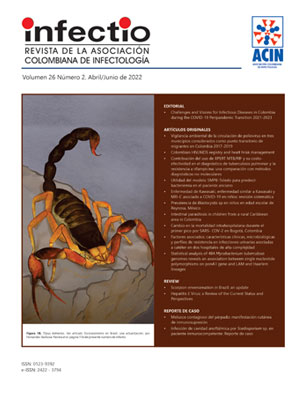Intestinal parasitosis in children from a rural Caribbean area in Colombia
Contenido principal del artículo
Resumen
In Colombia, the prevalence of intestinal parasitosis varies throughout its regions, social classes, and living conditions. We performed a cohort study (2017–2018) on children from 1–10 years old in El Cedro, Ayapel, Colombia. We tested a convenience sampling of those who accepted and signed the consent form. The National Intestinal Parasite Survey was applied; feces and water source sampling were tested for coprological and microbiology analysis, respectively. Education and pharmacologic treatment to the minor and co-inhabitants were performed. After the recruiting, we followed up at 7 and 12 months. Statistical analysis was performed using IBM® SPSS22. Participants 47, 61,7% male, average age 5,7 years. The caretakers had a low educational background. The monthly income of 72,3% of households was < USD 87. The coprological test showed 61,7% with at least one type of parasite; 32,2% with two or more. Trichuris trichiura was the most frequent. Water sources were positive for Escherichia coli. The population tested showed a high frequency of parasitic infection. We did not find a reduction of intestinal parasitosis with education and pharmacologic treatment at the end of the follow-up. It must be necessary to impact social determinants of public health to achieve intestinal parasitosis control.

